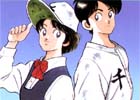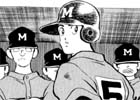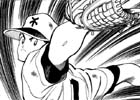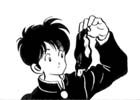H2
| Genre: Action/Drama/Romance | ||
| Length: 34 Volumes | ||
| Allegiance: Shogakukan | ||
| Mangaka: Adachi Mitsuru | ||
| Vintage: 1992 – 1999 | ||
| Intelligence Agency Report by: Kuzu Ryu Sen | ||
| Kunimi Hiiro and Tachibana Hideo were star members of the district champion Seinan Middle School baseball team. However, while Hideo went to Meiwa Ichi High as a touted prospect, Hiiro was diagnosed with a glass elbow and ordered to stop playing. To distance himself completely from his beloved sport, Hiiro is attending Senkawa High, a school without a baseball team. However, destiny seems to be against him, as he soon finds out that Senkawa indeed has a fledgling baseball club with the pretty Koga Haruka as its manager. To make matters worse, the soccer team that Hiiro’s joined seems intent on humiliating this baseball club in order to lure Haruka away. Faced with a showdown between the arrogant soccer team and Haruka’s baseball club on the diamond, Hiiro once again steps onto the mound, and takes a first step towards Koushien that he once never thought possible. | ||
|
|
||
| Research Agent Report by: Kuzu Ryu Sen | ||
| Plot Characters Impact Visual |
9.25 9.50 9.75 8.50 |
|
| Overall | 9.50 | |
| (not an average) | ||
| Once again, Adachi Mitsuru has produced a long running manga featuring high school baseball and a complicated web of romance. All the basic components – childhood friends, both familiar and unknown rivals, evil administrative officials, the Koushien – are there, but H2 is much more ambitious than Adachi’s previous work, Touch. This results in not only a deeper and more interesting cast, but also a plot that manages to maintain some degree of unpredictability, thus elevating H2 that extra step.
The first thing that H2 establishes right off the bat is that the tone of this manga will be relatively lighthearted, akin to Touch or Nine rather than Rough. The first few chapters are covered with word puns, physical gags, panty shots, and generally characters goofing around. As such, the first impressions on the reader delivered by the major characters are purely based on their personalities as opposed to some form of emotional baggage from a backstory. Through this gradual approach, the formation of a relationship network between the cast members felt more natural, meaning that the introduction of new characters into the status quo later on possessed the desired jarring effect. As a result, the attachment by the reader to the cast and their emotional investment in the manga increased. However, initial emotional investment can very easily lead to an embittered reader if the author does not develop his/her characters sufficiently to make that investment worthwhile. Readers of H2 will have no need to fear this situation, as not only are the main characters deep and multi-faceted, but the side characters and principal rivals receive attention unparalleled in any other Adachi titles. The overall plot is generally predictable, but Adachi throws more than a few curves in the path to that conclusion, and the majority of character relationships are not concretely established until the very last page. Make no mistake, H2, while quite similar in a lot of ways, is not Touch. Rather, it surpasses Touch in just about every key category, and is a romantic, comedic, dramatic, but most importantly, riveting tale of high school drama. This is Adachi Mitsuru’s magnum opus, without a doubt.
|
||




